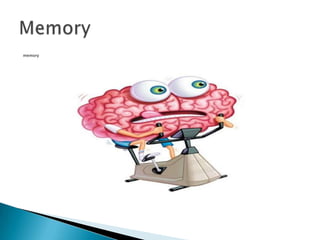
Memory oct 30
- 1. memory
- 2. Declarative learning involves facts and events, conscious recollection of information which can be verbally expressed eg facts and events, conscious recollection. Non- Declarative memory involves perceptual, stimulus-response and motor learning. Usually, there is no conscious recollection eg learning to ride a bike or playing an instrument.
- 3. • • • • • Most psychologists distinguish among 3 major systems of memory as identified by the Atkinson and Shiffrin Model Sensory Memory Short- term Memory Long-term Memory They serve different purposes and differ along two important dimensions – Span – how much info can be held – Duration- how long can the info be held
- 4. • Sensory memory – Brief storage of perceptual information before it is passed to STM – It buys our brains extra time to process incoming sensations. – It also allows us to fill in the blanks in our perceptions and see the world as an unbroken stream of events. – Psychologist believe each sense has its own form of sensory memory (iconic memory for vision echoic memory for hearing lasts 5/10secs)
- 5. • Short Term Memory /Working Memory – It is the memory store for the information we are currently thinking about, attending to or processing actively which retains info for limited durations. – Just how brief is STM? About 20 seconds – Memory loss for STM • Decay-fading of info from memory • Interference- loss of information from memory because of competing additional incoming info (memories get in the way of each other) – Retroactive interference – Proactive interference
- 6. • Short Term Memory – The capacity of STM • The magic number- the span of STM according to George Miller: 7 +/- two pieces of info • According to Miller it applies to more than digits it’s the universal limit of STM eg. When telephone digits are more than 7 digits long we begin making mistakes • Chunking –organizing material into meaningful groups allowing us to extend the span of STM. • Rehearsal- repeating info to extend the duration of retention in STM – Maintenance and Elaborative rehearsal
- 7. Long Term Memory (LTM) ◦ Sustained (from minutes to years) retention of info stored regarding our facts, experiences and skills ◦ Differences between long term memory and short term memory Capacity of Long Term Memory is huge Information is stored for years vs. 20secs
- 8. • Long Term Memory (LTM) – Primacy effect- seems to be affected by rehearsal and reflects the operation of LTM – Recency effect- seems to reflect the workings of STM – Types of LTM • Semantic memory • Episodic memory • Implicit memory
- 9. Semantic memory refers to the memory of meanings, understandings, and other concept-based knowledge , and underlies the conscious recollection of factual information and general knowledge about the world
- 10. Episodic memory is the memory of autobiographical events times, places, associated emotions, and other contextual knowledge) that can be explicitly stated. It is the collection of past personal experiences that occurred at a particular time and place. For example, if you remember the party on your 6th birthday, this is an episodic memory
- 11. Implicit memory is a type of memory in which previous experiences aid in the performance of a task without conscious awareness of these previous, eg When a skilled typist is typing on a keyboard, she does not need to look at each key. Instead, she is able to type without recalling the placement of each key, Once a person has learned how to ride a bike, repeated riding is implicit memory. The rider does not need to specifically recall each motion that needs to be completed.
- 12. • Encoding- Process of getting info into our memory banks – Many memory failures caused by issues with encoding. No coding, no memory – How can we enhance encoding? • Mnemonic – Pegword Method – Method of Loci – Keyword Method
- 13. Storage- process of keeping information in memory ◦ How we store information in memory depends on our interpretation and expectations of events ◦ Schemas –they equip us with frames of reference for interpreting new situations ◦ However they can lead us to oversimplify causing memory illusions
- 14. • • Retrieval- reactivation or reconstruction of experiences from our memory stores. Many types of forgetting result from failures of retrieval – Retrieval cues- hints that make it easier for us to recall information • Measuring memory – Recall – Recognition – Relearning
- 15. Retrieval (cont’d) ◦ Encoding specificity- phenomenon of remembering something better when the conditions under which we retrieve information are similar to the conditions under which we encoded it ◦ This principle is demonstrated in; Context-dependent learning State-dependent learning
- 16. Staying active seems to be the key to stabilizing memory change with age mental activity educational experiences, reading, crosswords etc. physical activity exercise healthy diet lower fat and lower cholesterol
- 17. Memory disorder is the result of damage to neuroanatomical structures that hinders the storage, retention and recollection of memories. Memory disorders can be progressive, including Alzheimer's disease, or they can be immediate including disorders resulting from head injury.
- 18. • • Amnesia – is a deficit in memory caused by brain damage, disease or psychological trauma. Amnesia can also be caused temporarily by the use of various sedatives and hypnotic drug. Hipocampal function plays a important roll in learning and memory
- 19. • • There are two main types of amnesia: Retrograde amnesia – is the inability to retrieve information that acquired before a particular date , usually the date of an accident or operation. Anterograde amnesia - is the inability to transfer new information from the short term store into the long term store. People with this type of amnesia cannot remember things for long periods of time
